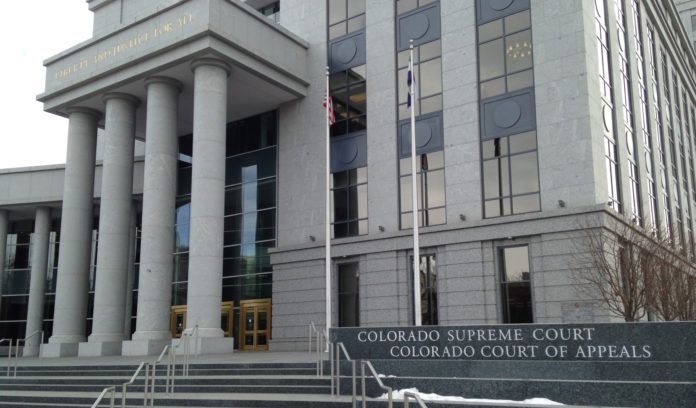

The Colorado Supreme Court will hear oral arguments in two criminal cases today, both arising from comments trial court judges made about “reasonable doubt” during the jury selection process. The judges attempted to explain the concept using analogies and examples so potential jurors could understand, but the defendants say these comments instructed the jury to lower the prosecution’s burden of proof.
Tibbels v. People
During Ernest Tibbels’ trial for menacing and possessing contraband, the court tried to explain the concept of reasonable doubt to potential jurors by way of analogy. The judge described a family who just found their dream home — except for “a crack in the foundation from the floor to the ceiling.” The judge likened this “structurally significant” crack to reasonable doubt, adding it is “something that you can kind of touch or feel or an inference that you may be able to draw.”
Tibbels was convicted of possession of contraband and sentenced to four years in the Department of Corrections. Tibbels appealed, arguing that the judge’s analogy lowered the prosecution’s burden of proof by setting too high of a bar for reasonable doubt. A split panel of the Court of Appeals affirmed Tibbels’ conviction.
In his appeal to the Colorado Supreme Court, Tibbels argues the trial court’s instructions improperly lowered the burden of proof, violating his constitutional rights to due process and a jury trial. This constitutes structural error, he argues, and requires reversal of the conviction.
In a cross-appeal, the state argues the judge’s “informal comments during voir dire” did not amount to instructions of law and therefore shouldn’t be reviewed as instructions subject to structural error analysis.
The high court will consider whether the judge’s analogy lowered the burden of proof in violation of Tibbels’ constitutional rights and, if so, whether other factors that occurred during the trial mitigate the harm of the judge’s instruction. The justices will also consider the question raised by the state: Are a trial court’s comments during voir dire “instructions” that, if improper, constitute structural error?
Pettigrew v. People
In the second case about a judge’s explanation of reasonable doubt, the judge’s comments occurred early in the jury selection process for the trial of William Pettigrew, who was eventually convicted of pandering of a child and tampering with a witness or victim.
When speaking with a prospective juror, the judge said reasonable doubt is “pretty hard to define” and the definition in the law is “a little inadequate.” The judge went on to illustrate an “unreasonable” doubt by asking a potential juror’s birthday — Nov. 18 — and how he knows that is his birthday. The juror answered he knows it is his birthday because it’s on his birth certificate, which is an official hospital document.
The judge responded that sometimes hospitals make mistakes and clerical errors and asked whether the juror had any other reason to believe that was his birthday. The juror said his parents say Nov. 18 is his birth date, but the judge pointed out that the juror’s “mother probably wasn’t thinking of the date” when he was born.
“I can throw out maybe your birth certificate is wrong, maybe your mother wasn’t aware of the date,” the judge said. “But I would suggest to you, Mr. [Juror], on November 18, you are going to recognize that as your birthday, aren’t you?” The juror agreed, and the judge said, “because I haven’t created a reasonable doubt, have I?”
Another potential juror asked why Pettigrew wasn’t being charged with child pornography, and the judge responded, “maybe because there’s no evidence that he committed another offense.” The judge added that “we try people when there’s evidence to support the charges.”
When speaking to yet another potential juror, the judge attempted to distinguish between “innocent” and “not guilty,” explaining that if the defendant is innocent, that means he “didn’t do anything” — for example, he was out of the country when the crime was committed. “But that’s not how we look at trials in this country,” the judge said, adding that “trials in this country are a test of the prosecution’s evidence.”
Pettigrew argues the trial court’s instructions and comments lowered the burden of proof and undermined the presumption of innocence. In particular, Pettigrew says, the birthday example trivializes the prosecution’s burden, especially since the judge had just criticized the legal definition of reasonable doubt and portrayed himself as an internationally recognized criminal justice expert to the potential juror.
Pettigrew argues the judge’s other comments suggested “there was some evidence” against the defendant, the court was aligned with the prosecution and only a defendant “who didn’t do anything” was innocent, minimizing the presumption of innocence. Pettigrew also challenges the Court of Appeals’ finding that a warrant and affidavit to search his mobile phone satisfied the Fourth Amendment’s particularity requirement.
In its response brief, the state says that although “providing examples and hypotheticals during voir dire is disapproved of, doing so does not necessarily constitute reversible error” and it is not likely the jury applied the instructions in an unconstitutional manner. As in the Tibbels case, the state argues that the court’s comments were not instructions of law and didn’t undermine the fundamental fairness of the trial.

